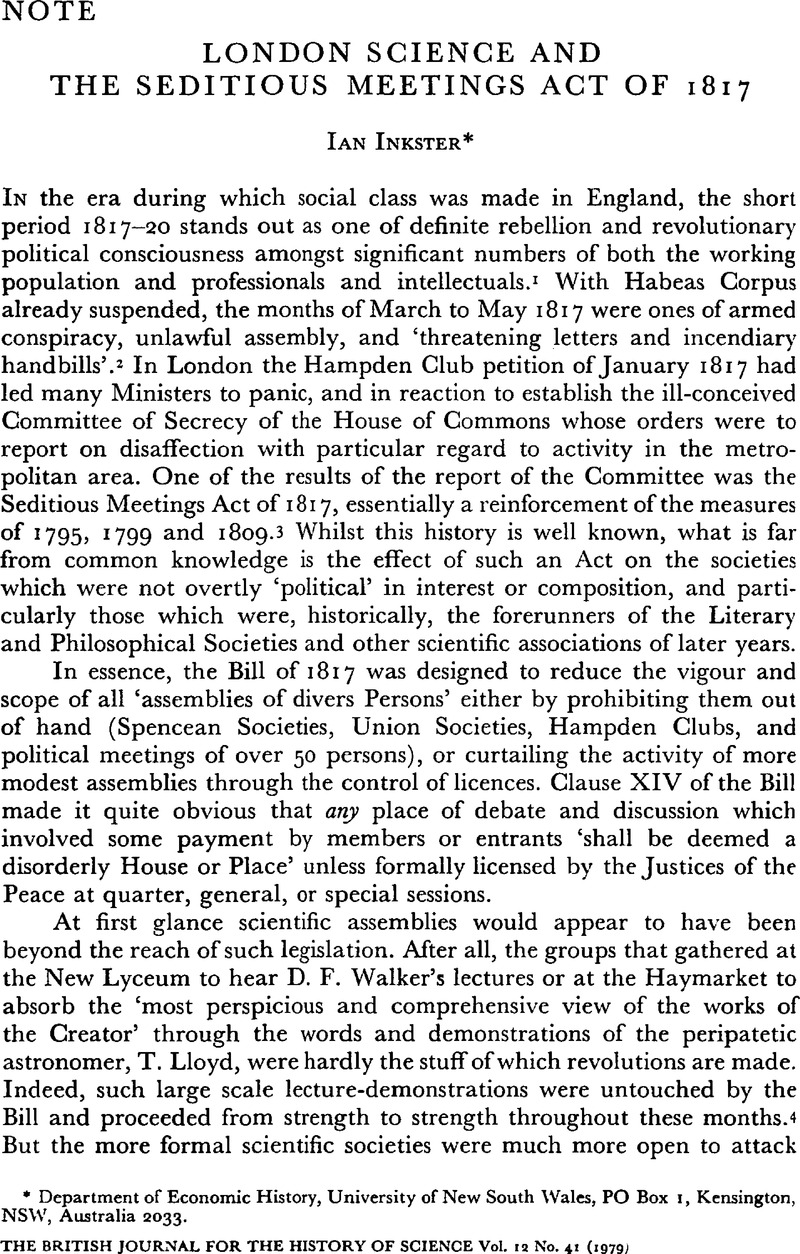Article contents
London Science and the Seditious Meetings Act of 1817
Published online by Cambridge University Press: 05 January 2009
Abstract

- Type
- Note
- Information
- Copyright
- Copyright © British Society for the History of Science 1979
References
NOTES
1 For the debate on the social and historical significance of such disturbance see Thompson, E. P., The making of the English working class, London, 1963Google Scholar; Donnelly, F. K., ‘Ideology and early English working-class history: Edward Thompson and his critics’, Social history, 1976, 2, 219–38CrossRefGoogle Scholar; and Donnelly, F. K. and Baxter, J. L., ‘Sheffield and the English revolutionary tradition, 1791–1820’, International review of social history, 1975, 20, 398–423.CrossRefGoogle Scholar
2 The Observer, 26 05 1817.Google Scholar
3 Pellew, George, Life and correspondence of Henry Addington, First Viscount Sidmouth, 3 vols., London, 1847, iii, 163–206.Google Scholar
4 e.g. The Times, 15 02, 5 03, 5 05 1817Google Scholar; 21 January, 6 February 1818.
5 Quoted by Thompson, op. cit. (1), p. 651.Google Scholar
6 The Times, 14 05 1817.Google Scholar
7 Parliamentary debates (Hansard), 1817, 35, 1217–18.Google Scholar
8 Ibid., p. 944.
9 Ibid., pp. 851–2.
10 The Times, 16 01 1817.Google Scholar
11 Ibid., 10, 22, 29 January 1817; 10 January, 4, 6, 10 February 1818.
12 Parliamentary debates, 1817, 35, 1109.Google Scholar
13 Ibid., 1817, 36, 17–21.
14 The Times, 5 05 1817.Google Scholar
15 Parliamentary debates, 1817, 35, 1222–9Google Scholar; 1817, 36, 93–4, The Times, 27 02, 25 04 1817.Google Scholar
16 The Times, 20 05 1817.Google Scholar
17 The society was purely scientific in nature, and was expertly guided and inspired by the scientist John Tatum, of Dorset Street, a well known metropolitan lecturer. See Nicholson's journal, 1807, 16, 81–2Google Scholar; 1807, 17, 149–51; 1807, 18, 80, Philosophical magazine, 1809, 34, 237–8Google Scholar and The Times, 5 05 1817.Google Scholar The CPS was one of several associations formed in London during the first decade of the century, other including the Southwark Philosophical Society, the London Chemical Society, and the Hackney Literary and Philosophical Society. For further information on these and the CPS see Ian Inkster, ‘Science and society in the metropolis: a preliminary examination of the social and institutional context of the Askesian Society of London, 1796–1807’, Annals of science, 1977, 34, 1–32.Google Scholar
18 Parliamentary debates, 1817, 36, 83–7.Google Scholar
19 Ibid., p. 86.
20 The Times, 26 04, 5 05 1817.Google Scholar
21 Parliamentary debates, 1817, 36, 84Google Scholar; Liverpool mercury, 9 05 1817.Google Scholar
22 Quarterly review, 1816–1817, 16, 225–78, 511–52.Google Scholar The effect of the Bill on the provincial setting is further examined in a paper in preparation entitled ‘Science beyond the pale—the effect of the Sedition Bills from the 1790s to the 1820s’.
23 Parliamentary debates, 1817, 36, 1034–85, 1087–8Google Scholar; The Times, 14 02 1817.Google Scholar
- 9
- Cited by




